Viñales Valley
Viñales Valley (Spanish: Valle de Viñales) is a karstic depression in Cuba. The valley has an area of 132 km2 (51 sq mi) and is located in the Sierra de los Órganos mountains (part of Guaniguanico range), just north of Viñales in the Pinar del Río Province.
| Viñales Valley | |
|---|---|
| Valle de Viñales | |
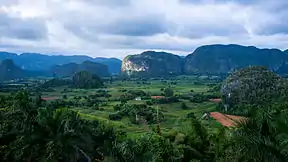 View of the Viñales Valley | |
| Area | 132 km2 (51 sq mi) |
| Geography | |
| Coordinates | 22°37′N 83°43′W |
| Type | Cultural |
| Criteria | iv |
| Designated | 1999 (23rd session) |
| Reference no. | 840rev |
| State Party | Cuba |
| Region | Latin America and the Caribbean |
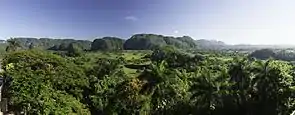
Overview
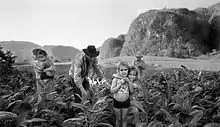
Tobacco and other crops are cultivated on the bottom of the valley, mostly by traditional agriculture techniques. Many caves dot the surrounding hillfaces (Cueva del Indio, Cueva de José Miguel).
The conspicuous limestone cliffs rising like islands from the bottom of the valley are called mogotes. They can be up to 300m tall.
Viñales is a major tourist destination offering mainly hiking and rock climbing. The local climbing scene has started to take off in the last few years with many new routes being discovered resulting in an increase in local tourism.[1]
Geography
There are some mountain formations, unique in the island, called mogotes. These mogotes constitute unique geomorphological formations where some of them come to measure great height. These mogotes resemble a great diversity of forms because they are only comparable with those located in China and the peninsula of Malacca.
In the valley, there are other elevations, such as Alturas de Pizarras, which are formed by a variety of rocks, the oldest existing throughout the country and also in the Caribbean area.
Conservation
Many endemic plants and animals are specific to this valley. Flora found in the region include Bombax emarginatum, mountain palm (Gaussia princeps), Ekmanianthe actinophilla, and Microcycas calocoma. Fauna includes bee hummingbird (Mellisuga helenae, zunzún), Cuban trogon (Priotelus temnurus), Cuban tody (Todus multicolor), Cuban solitaire (Myadestes elisabeth) and Cuban grassquit (Tiaris canorus).[2]
Mural of Prehistory

In the valley of Dos Hermanas, we can find the Mural of Prehistory, which is painted on a stone of one of the elevations. This mural shows the evolution of life in a natural sense of Cuba.
The Mural of Prehistory is located in the mogote called Pita. It can be found on a perpendicular slope. The rock was washed and drains were also made in it to avoid erosion in the future due to the rain. It is 120 meters high and 160 meters in length. The artist was Leovigildo González Morillo, who was Director of Cartography of the Academy of Sciences of Cuba.
In it are represented Guanahatabeyes Indians, species of mammals, gigantic animals, as well as some mollusks.
In the Mural can be seen in 12 pieces the evolutionary process of men and animals in the Sierra de los Organs, in its different stages.
Photo gallery
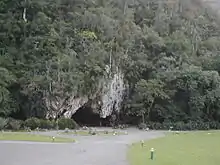 Palenque de los Cimarrones
Palenque de los Cimarrones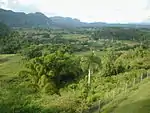 Viñales Valley
Viñales Valley Viñales Valley
Viñales Valley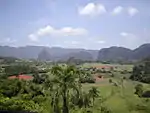 Viñales Valley
Viñales Valley.jpg.webp) Viñales Countryside
Viñales Countryside
References
- High Sports. "Article on Cuban Climbing". Retrieved 2008-04-07.
- Radio Habana. "Parque Nacional Viñales" (in Spanish). Archived from the original on 2007-10-05. Retrieved 2007-10-10.
External links
| Wikimedia Commons has media related to Viñales Valley. |
- UNESCO Viñales Valley webpage
- Main website for rock climbing in Cuba, especially Vinales.
- Calzadilla, Erasmo (2009-06-18). "Dago's Life in Viñales, Cuba". Havana Times.
